 Russian Empire, 1902-1914. Protected Cruisers: Izumurud, Zhemchug
Russian Empire, 1902-1914. Protected Cruisers: Izumurud, ZhemchugIzumrud (“Emerald”) was a protected cruiser of the Imperial Russian Navy, Russian built like her sister ship Zhemchug, but derived from the German Schichau design “Novik”. Both were part of the expansion program of the Russian Pacific Fleet, to be based on the recently acquired Port Arthur after the 1894 Sino-Japanese war, a better spot than the ice-clogged Vladivostok, to counter the rising Imperial Japanese Navy and its threat to Manchuria and Korea. At the end of the Battle of Tsushima, Izumrud’s captain refused to surrender and tried a mad dash to Vladivostok through the Japanese blockade, but in the night of 28 May, she ran aground in Vladimir Bay and was lost, abandoned and scuttled. Her sister Zhemchug (“Pearl”) also took part in the battle and fled with three ships, taking refuge in neutral Manila until the end of the war. She was sunk in the Battle of Penang, 28 October 1914 against SMS Emden. #ww1 #russianimperialnavy #russianavy #russkyflot #izumrud #portarthur #russojapanasewar
Development
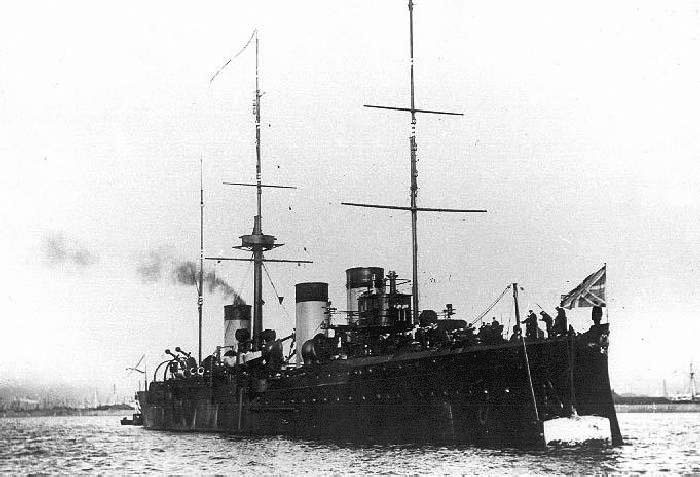
The moored Izmurud, extract from a postcard
Izumrud (“emerald”) and Zhemchug (“pearl”) were basically Russian-built copies of the new Novik built at the German Schichau yard, Danzig. At the time the Russian Navy was interested in a fast scout, lightly protected, and from this Nevsky Shipyard in St. Petersburg was tasked of duplicating the design between 1901 and 1904. How it happened is the following process:
In 1898 were written tactical technical specifications (TTZ) for the design and construction of a “small” high-speed scout cruiser for the Pacific fleet. As Rusian Shipyards were already budy and lacked experience, the bid was open to the world’s companies. Yards in Germany, Britain, Italy, France, USA, Denmark, all participated, but the recent Nevsky Shipyard was also informed. It entered the competition for the design and construction of a scout under technical assistance of Vikers. Soon after, German Schichau yard won the bid. The Nevsky Plant was thus forced to adopt the German working drawings of the Novik, taking into account its local capabilities and using at best the skills and expertise of its British partners for technical assistance.
While maintaining the same hull and dimensions of Novik, the working drawings prepared at Nevsky Plant planned the adoption of British-made boilers and machinery, as well as changing the armamernt composition. It is noteworthy that the Schichau did not provide displacement specification and when testing the prototype Novik, changes were repeatedly made to the plans of the Zhemchug class, while Schichau did not fulfilled obligations of information, which slowed down the finalization of the design.
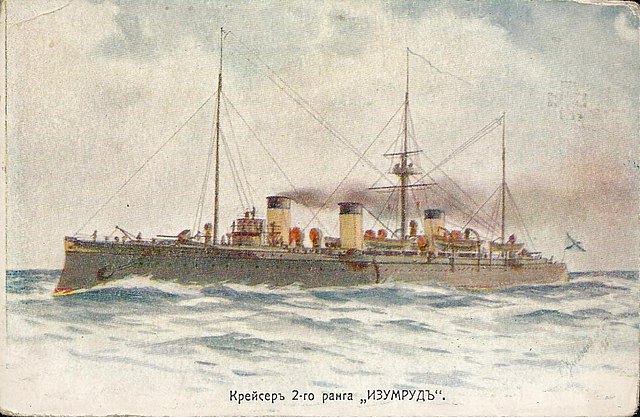
Postcard ofthe Community of Saint Eugenia, Cruiser 2nd rank Izumrud by Vsevolozhsky.
At the start of 1904, it was decided to place light wooden masts instead of a single military mast on Novik to simplify construction.
In February 1904, S. O. Makarov, in a latter to Ministry of the Navy F. K. Avelan, proposed to modify the design slightly into basically unprotected cruisers in order to gain more speed. Calculations of naval engineer P.F. Veshkurtsov calculated that by removing all protection and part of the boilers, a weight reserve of 270 tons could be obtained. Thus it was proposed in exchange to strengthen the torpedo capacity and artillery. It was proposed to install a single 203 mm (8-inches) heavy gun forward, five 152 mm (6 inches) secondary guns and ten 75 mm (3-inches) guns and four torpedo tubes while strengthening the hull.
In the freed engine room it was recommended to install two auxiliary engines of 100 liters capacity each “for quiet cruising” and night operations. At the same time, the design speed was decreased by 2.7 knots at 22.3 knots based on an idea 25 24 knots. But it was overruled at higher level due to the emergency in the Pacific, and such reconstruction was cancelled, as the new ship would barely have time to be prepared to join the 2nd Pacific Squadron. The only remaining proposal was the installation of three torpedo tubes on either cruiser.
In mid-March 1904, the plant set the deadline for delivery of Zhemchug by July 1, 1904. The working draft was once again revised, taking into account experience of previous naval combat, and it was decided to additionally install two more 120-mm guns, removed from the old cruiser Dmitry Donskoy. In addition, two torpedo tubes were installed and mechanical semaphore purchased from Schichau. The latter was a first in the Russian Navy.

Design of the class
The design displacement increased from 3,000 to 3,380 tons while maintaining the theoretical hull and main dimensions. Both sisters would also differ in some detailed specs, reported here, but they did zldo differ in appearance. By the way depending on the author’s nationality, the class was named either from the lead laid down, or lead launched vessels. In Russian they are called the “Zhemchug class”, 2nd rate. In western publications, the Izumrud class, alveit she was launched later than her sister. Жемчуг (Zhemchug) was laid down at St. Petersburg on 27.6.1902, launched on on 9 September 1903 and completed in 10/1904 whereas her sister Изумруд (Izumrud) was laid down the same day on 27 June 1902 but she was launched on 22 October 1903 and on paper, completed the same on 10/1904.
Hull and general design
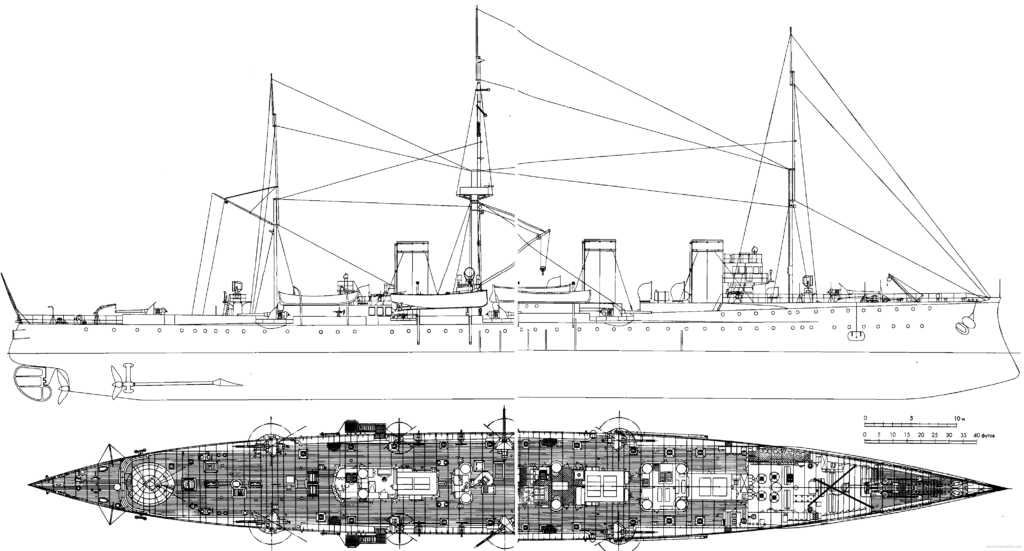
See also
Both cruisers kept the same hull as Novik, narrow and ending at one side with a ram, on the other on pointed stern. The hull lines had been optimized for speed at the origin (Schichau was specialized in torpedo boats), and so they kept the best hull design as scout cruisers.
Protection
Novik has an armored deck along the entire length from the ram to the sternpost, 30 mm in flat, 51 mm on the sloped sides, in chromium-nickel armor. Parts of the torpredo tubes protruding above the armored deck were covered by 70-mm glacis or 25 mm in other sources, and it had a conning tower with 30 mm walls in Krupp armor, whereas gun shields were 25 mm thick.
To compare, Zhemchug’s armoured deck was 30 mm on flat, 50 mm on the slopes and same for the conning tower and Izumrud same but with a glacis of 70 mm.
Powerplant
Novik was originally built with twelve Shichau water tube boilers mated to three vertical steam triple expansion steam engines for a total of 17,800 hp on trials, 17,000 hp as designed, thre propellers.
Zhemchug like her sister had sixteen Yarrow water tube boilers plus three vertical triple expansion steam engine for 11,180 hp. (8.22 MW) in natural draft and also three propellers, 17,000 hp with forced heating.
Novik was rated at 25 knots, on trials she reached 25.1 knots. She carried 400 tons of coal in normal conditions and in wartime 510 tons for 5000 nautical miles max. tested 2,900 nm at 10 knots.
“Pearl” (Izumrud) was rated at 24 knots (44.4 km/h) and 4,500 miles at 10 knots and her sister “Emerald” (Zhemchug) 23 knots and 5,000 miles at 10 knots or 24 knots for other sources. She could steam over 710 miles at 20 knots and 2,090 miles at 12 knots.
Armament
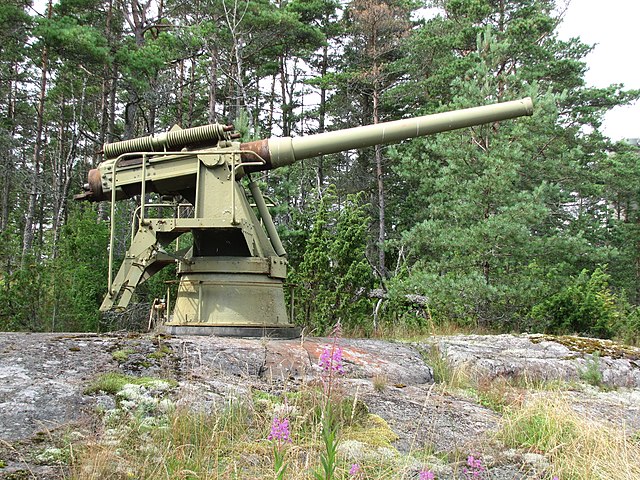
120 mm Canet gun preserved on Finnish Kuivasaari Island.
As customary at the time under French influence, armament was either imported from France or licence-built by Obukhov. Novik was armed with six 120mm/45 Canet guns and six 47mm Hotchkiss (43 caliber) as well as two 37 mm Hotchkiss guns (23 caliber) that van be mounted on its own steam cutters, and for landing parties a 63-mm Baranovsky landing gun (19.8 calibers) as well as two 7.62 mm Maxim machine guns, also carried by boats if needed on a proper wheeled mount. There were five torpedo tubes, one at the stern and four on the broadside, all 381 mm.
The Izumrud class had eight 120 mm/45 Canet guns, six 47-mm/43 Hotchkiss, two 37-mm/23 Hotchkiss, one 63 mm Baranovsky landing gun and four 7.62 mm Maxim MGs, plus three 381-mm surface torpedo tubes with 11 torpedoes in reserve. Some sources speaks of six Maxim MGs.
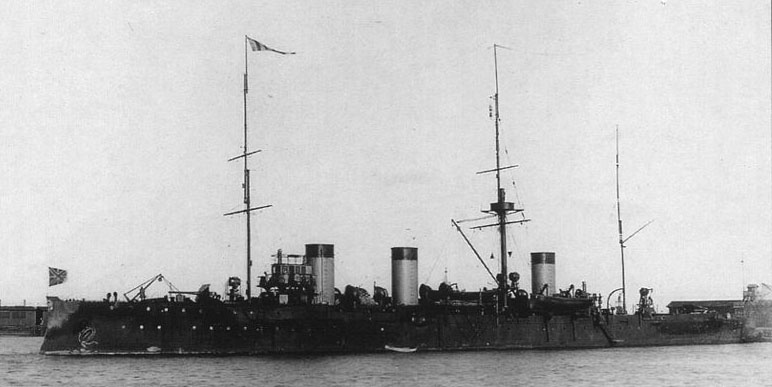
Izmurud 1901-1905
Main
The six 120 mm 45 caliber Pattern 1892 (designed 1891, service from 1897) were placed in a lozenge pattern, one in axis on the forecastle and one on deck aft, two sponsons either broadside. They had perhaps 200 rounds for each in store, but no definitive info.
were manufactured at Obukhov, Perm under licence. They had an unfastened barrel, which was made from an inner tube fastened with a casing and an extra ring and were adopted for their amazing rate of fire, thanks to their fixed ammo. They fired a wide range, Armor Piercing, Chemical, High Explosive, Illumination, Incendiary, SAP, Shrapnel types. However manufacturing issues at Obukhov meant many had bursting barrels. 83 were made and they soldiered on until 1941 for some.
⚙ specifications 120 mm/45(4.7 in) Obukhov-Kane Pattern 1892 |
|
| Weight | 2.95 t (3.25 short tons) |
| Barrel lenght | 5.4 m (17 ft 9 in), barrel 4.2 m (13 ft 9 in) |
| Elevation/Traverse | -7° to +20° |
| Loading system | Piston type design breech |
| Muzzle velocity | 823 m/s (2,700 ft/s) |
| Range | 11.8 km (7.3 mi) at +20° |
| Crew | 8 ? |
| Round | Fixed QF ammunition 20.4 kg (45 lb) |
| Rate of Fire | 12-15 rpm |
Secondary
Hotchkiss 47 mm L/40 M1885 & QF 3-pounder: Well known anti-torpedo boat rapid fire light cannon made by Hotchkiss, France. They were placed on central pivot mounts.
⚙ specifications Hotchkiss 47 mm/40(1.9 in) |
|
| Weight | 240 kg (530 lb) |
| Barrel lenght | 2 m (6 ft 7 in), barrel 1.8 m (5 ft 11 in) 40 caliber |
| Elevation/Traverse | -8° to +20° |
| Loading system | Vertical sliding-wedge Breech |
| Muzzle velocity | 571 m/s (1,870 ft/s) |
| Range | 5.9 km (3.7 mi) at +20° |
| Crew | 8 ? |
| Round | Fixed QF 47 × 376 mm R, 3 kg (6.6 lb) full, proj. 1.5 kg (3.3 lb) |
| Rate of Fire | 30 rpm |

2nd class cruiser Izmurud postcard by Apsotoli
The 37 mm were pivot-mounted six-barrel rotative rapid fire guns. They used the Gatling system, loaded by gravity with small capacity magazines. See full details on the artillery section.
The Baranowsky guns and Maxim MGs had bee treated in previous ships, and more relevant to naval infantry.
As for the torpedoes, these were Whitehead 381 mm or 14-inches torpedoes (“mine” in Russian) and measured 5.45 m, carrying a black powder charge of 38.5 kg at around 1000 m range. Three, one in the bow, two broaside, placed just over the armour deck. 11 torpedoes in reserve.
 Izumrud
Izumrud

After completion, Izumrud was to be sent to the Pacific as soon as practicable and stationed in Vladivostok. But before the war started she was still like her sister training with the Baltic fleet.
After the attack on Port Arthur on the night of 8 February 1904, Novik was the only ship trying not be caught off guard and later took part in the Battle of the Yellow Sea on 10 August 1904, outrunning her opponents and helping other ships escape until cornered in Aniva Bay and scuttled. She was refloated later by the Japanese and served for 6 years as Suzuya.
Izumrud and Zhemchug after the raid on Port Arthur were ordered sent from the Baltic to reinforce Port Arthur.
At the Tsushima Straits, after sailing 18,000 kilometres (11,000 mi) she was part of the Second Pacific Squadron under Captain 2nd Rank V.N. Ferzen. During the battle, she fired many rounds with some claimed hits, while successfully evading Japanese shells but taking still three hits, without losses. She was the only cruiser which did not fled the squadron after the battle. At night she guarded the remnants of the Second Pacific Squadron from destroyers. The following day the Japanese simply surrounded the cruiser without firing, hoping to gain a surrender an capture the cruise intact. With battleships all around and having enough ammunition and coal, the ships still present and heavily damaged, decided to surrender, signal being raised, but Captain Ferzn having a still intact ship, he decided to disobey and leave the blockade after confering with officers and make a crew announcement. She managed to break down at full speed the encirclement. It was decided to head for Vladivostok.
Ferzen, however, while on its way to Vladivostok, however asked to change course, and the cruise “slipped” past Vladivostok by 180 miles, then ordered another wrong course when entering Vladimir Bay, and was grounded, despite pleads from officers present. Fearing the approach of enemy ships and not waiting for the tide to refloat his ship, he decided, perhaps out of panick, to scuttle his cruiser, abandon ship and proceed on foot to Vladivostok. Later authors would explain this by the sum of nervous tension and lack of rest (which was true for the entire crew). But his erratical behavious cost the depleted Russian Navy a perfectly able ship.
Some tried to explain later his behavious by the likelihood of unreported minefield to the approaches to Vladivostok and reluctance to surrender to the enemy that were probably hot on his heels. Whatever the case, the crew evacuated in good order to the shore. The scuttling was well done apparently as she was not recuperated by the japanese. Her wreck was dismlantled years after the war.
 Zhemchug
Zhemchug
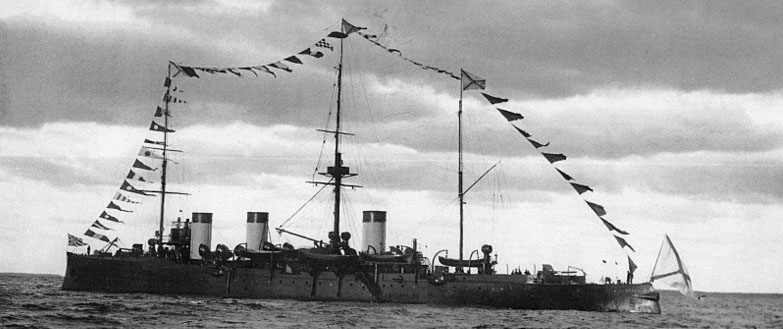
Zhemchug in 1904 at Reval during the parade.
“Pearl” was officially laid down in presence of Grand Duke Alexei Alexandrovich but construction was slowed by design revisions and sub-contractor’s delays. On June 11, 1903 boilers itests and installation was made, and she was launched on August 14, 1903, in presence of Emperor Nicholas II, escorted and saltuted by destroyers “Buiny”, “Bravey” and “Bodriy” with 31 shots. Captain 2nd rank P.P. Levitsky was appointed commander until the end of her fitting out.
On December 2, a storm her her torn off its moorings, got stuck on an ice bank, but she was undamaged. After the outbreak of the Russo-Japanese War, completion work was significantly accelerated. In mid-March 1904, a strick deadline was set on July 1, 1904 and 480 craftsmen with rotating teams worked day and night. As it happened after news came from the initial fight at Port Arthur it was decided to add two more 120-mm guns taken from the cruiser Dmitry Donskoy. They were added admiship on limited sponsons, under shields like the rest. She thus differed from her sister by having eight instead of six main guns. In addition, two torpedo tubes and a mechanical semaphore from Schichau were installed, a first. Vice Admiral F.K. Avelan and the commander of the Second Pacific Squadron Z.P. Rozhestvensky visited the yard several times, encouraging workers.
On July 26, “Pearl” (Zhemchug) started mooring tests, on August 5, she sailed to Kronstadt and in trials she ran at 23.04 knots with 250 tons of practical load. All deficiencies discovered were corrected quickly at Revel. On August 29, she was accepted in the Second Pacific Squadron. On September 27, there was an Imperial review in Reval, during which Nicholas II visited her and encouraged the crew and officers. On September 28, the squadron left Revel in two columns for Libau. She was in right column, behind the transport “Anadyr”. In Libau, she made up for extra coal reserves. On October 2, she left the Baltic, following the cruiser Almaz (flagship, Rear Admiral Enquist), being third in the column behind Svetlana. During the trips, breakdowns occurred and were corrected on the move. Training was intensive as well for her green crew.
On October 21, the Second Pacific Squadron arrived in Tangier. Smaller draft vessels were authorized to carry out by the short route via the Suez canal while the rest would circle africa and all would met to Madagascar. Zhemchug arrived on February 1, 1905 off Madagascar. She was part of the “Pursuit Detachment”, with her sister Izumrud. She took part in Joint exercises, firing drills and evolutions and she was praised fir her skilfull maneuvering. On March 3, both cruisers were assigned with the main force and took place in the right and left abeam of the flagship “Prince Suvorov”. Extra coal was loaded from the Russian coalers under tropical heat and degrading weather.
On May 6, Zhemchug captured the Norwegian steamer Oscar II which seemingly reported the presence of the Russian squadron.
Battle of Tsushima:
After the Second Pacific Squadron approached the Tsushima Strait and was discovered by Japanese scouts, Zhemchug spoted them in return at 7.00. and requested a chase until confirmed by the commander. Around 11.00 she caught up and fired on Japanese ships and by 12.00, already in the Tsushima Strait, all ships changed course to the northeast and Zhemchug was ordered to move abeam the “Eagle” followed by her sister and four destroyers of the 1st TBD detachment.
At the start, Zhemchug captain ordered to open fire at least to raise morale but after Oslyabya was badly mauled, headed towards her, received a 152 mm hit. Lieutenant Baron Wrangel was killed and all stern gun crews were wounded. While manoeuvering under enemy fire she almost collided with the auxiliary cruiser “Ural” and narrowly break off her right side stern, hooking her right propeller onto her hull, and loosing one torpedo tube.
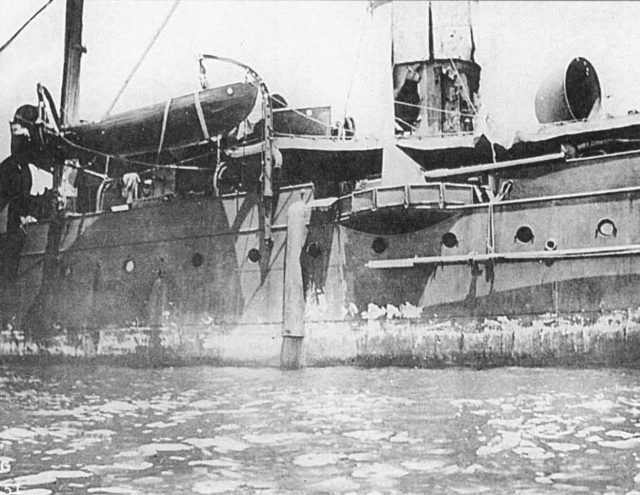
Damage to the Zhemchug after the Battle of Tsushima
At 2 p.m., she was hit by another 120-mm shell, and took heavy damage to her right waist gun, shells intended for quick reloads buesting in flames, almost killing midshipman Ratkov, and she soon joined the cruisers detachmemnt, taking position in the wake of the Vladimir Monomakh, exchanging fire with Japanese cruisers attacking transports. The captan decided not to be back to the battleships, not risking his cruiser. As the battle ended she had taken 17 hits, her funnels were peppered by shrapnels, as her hull and she had 12 killed, including two officers, 30 injured.
She left the area under Rear Admiral O. A. Enquist, sailing left of Aurora, not back to Vladivostock which was blocked, but south. At night they changed course, but ran into Japanese destroyers again. Captain 2nd Rank Levitsky received order to follow the detachment to Manila, officially for repairs. On May 21, they arrived but by May 25, St. Petersburg naval staff ordred them to stay interned until the end of hostilities and not trying to get back to the Port Arthur.
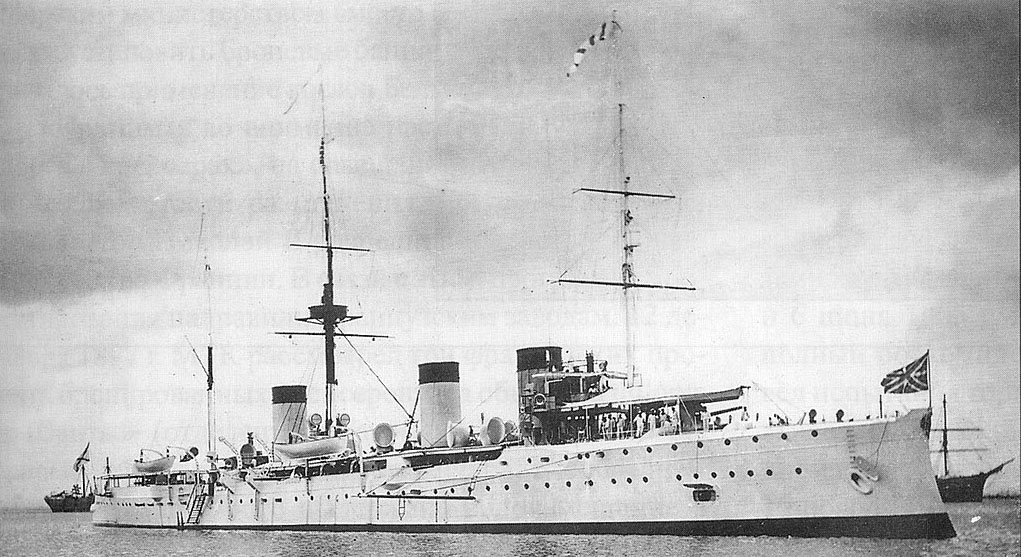
Izumurud in Vladivostock postwar in 1906 as part of the Siberian flotilla
After peace was concluded with Japan, Zhemchug was prerpared to sail home to Russia. Before that she headed on october 14 to Vladivostok and entered the Siberian flotilla. During the uprising in Vladivostok on January 10, 1906, her crew joined the mutineering garrison, they took part in street battles and nearly killed their officers. After the unrest was quelled, her crew was disarmed and written off to shore with 402 sailors put on trial.
Despite her poor condition, Zhemchug made training cruises in the bays of Primorye alternated on Shanghai station with the gunboat Manzhur, as well as ports visits, Chinese, Korean and Japanese and was used as target for submariners. In 1910, she was drydocked for well deserved maintenance.
She spent the 1911 season as flagship ship of the flotilla for short trips. In May 1911 she was inspected by the Minister of War and the rest of the flotilla in Peter the Great Bay, for aboard. In 1912, Zhemchug was placed in 1st class armed reserve. Captain 2nd Rank Ivanov took command. In 1913 she was on station duties in Shanghai and Hankow. In early 1914 she reported on the revolution and civil war in China. In mid-May she returned to Vladivostok, a month later captain 2nd rank Baron I. A. Cherkasov took command and trained until August 1914.
At 5:30 a.m. on July 20, 1914, it was signalled from the cruiser Askold that the war broke out, the flotilla was put on alert, knowing about the German East Asia squadron not that far at Tsingtao. Permission was requested to scramble Askold and Zhemchug to join the Allied fleet under Vice Admiral Jeram. It was agreed on August 24, and both sailed for Hong Kong the following day. On September 3 they took on board English liaison officers and split up near the Philippines, inspecting for possible German incursions there. By September Zhemchug escorted British and French transports loaded with troops and cargo.
On September 27, Zhemchug headed for Singapore, escorting French transport. After 5 days there she moved to Penang escorting four transports. From there, she sailed to the Nicobar Islands in search of the signalled German raider Emden. But due to boiler issues she was ordered back to Penang. Cherkasov requested permission from Vice Admiral T. Jerram, to overhaul the machinery, alkalize the boilers, which was granted. All boilers, except one were taken out of operation, despite knowdledge this remaining one could not provide the required energy notably for shell elevators and drainage facilities. On October 14, Cherkasov’s wife arrived in Penang and he went ashore but orded in case to keep loaded guns facing the entrance to the roadstead.
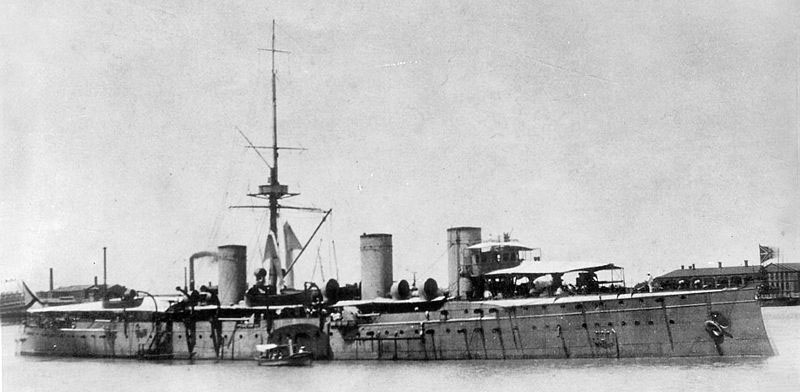
Zhemchug before 1914, in grey livery
Battle of Penang:
At 4:50 on October 15, Emden, entered it all lights shuts and with a fake funnel erected to look like the town class HMS Yarmouth, knowing to roam these waters. She was even freely admitted by patrol ships, and by its manager, McIntre, and sent Lit. Mound on Zhemchug to point out this arrival and urge precautions to the commander. Still it was decided to sent the French destroyer Mousquet into the passage. Two other French destroyers were moored against the berth, crews asleep. The aviso D’lberville at least had an officer on watch that also reported the incoming cruiser. Her noted in his log book:
About 5 a.m. on October 28, a four-funnel cruiser (the fourth funnel was a fake), painted, like our cruisers, dark gray, appeared at the entrance to the harbor. The flag raised on the gaff was mistaken for English, and the patrol boat, without even questioning him or warning the Pearl, allowed him to pass freely
On Emden the senior officer commented:
Everyone had already decided that the expedition had failed, when suddenly, among these “merchants” standing with anchor lights and with portholes lit from inside, some dark silhouette appeared without a single light. This is, of course, a warship. A few minutes later we were close enough to be convinced that this was indeed the case. <...> Finally, when the Emden passed at a distance of about 1 cable under the stern of the mysterious ship and came abeam to it, we finally established that it was the cruiser Zhemchug. Peace and silence reigned there. <…> From a distance of about 1 cable. we fired our first mine from the right side vehicle and at the same moment opened fire with the entire side on the bow of the Zhemchug…
Panic soon broke out on Zhemchug, part of the crew even jumped overboard. Officers managed to restore order, but gun cerws were unable to find the shells since supply elevators were not in working order, having no electricity. Senior artillery officer Rybaltovsky personally opened fire from the working stern gun still and claimed two hits. Watch chief midshipman A.K. Sipailo, managed to fire from the 66 mm land gun, but was immediately killed. A few minutes later the cruiser, now abeam Zhemchug, fired a torpedo, which hit the magazine. A column of smoke and flame immediately lit up the whole reoadstead up to 150 m. This was enough to break her keel, and she soon break in two, her prow sinking first, and after 15 seconds, only howeved the top of the mast, while her aft section remained afloat thanks to bulkheads but still filled quickly.
Leaving the harbor, Emden sank the French destroyer Mousquet and escaped. Meanwhile, Zhemchug crew was being rescued and counts were made: 80 missing, presumed dead, 7 more which later died from wounds, 9 officers and 113 ratings injured in varying degrees. On January 4, 1915, the auxiliary cruiser Orel arrived in Penang to evacuate these and depitach divers to examine the wreckage. They managed to lift off a 120 mm gun, a machine gun and 6 optical sights. A month later, she left for Singapore. A commission was created wich later put all the blame on Baron I. A. Cherkasov and senior officer N. V. Kulibin. The wrecked was dismantled the 1920s by a British team.
Read More/Src
Books
Budzbon, Przemysław (1985). “Russia”. In Gray, Randal (ed.). Conway’s All the World’s Fighting Ships 1906–1921
Campbell, N. J. M. (1979). “Russia”. In Chesneau, Roger & Kolesnik, Eugene M. (eds.). Conway’s All the World’s Fighting Ships 1860–1905.
Buyakov A. M., Kritsky N. N., Shugaley I. F. The last battle of the cruiser “Zhemchug”. Vladivostok: Publishing house 2004.
V. V. Khromov. Cruisers of the “Pearl” type A. S. Raguzin. Modelist-constructor, 2005.
Cruisers “Pearl” and “Izumrud”; Alliluev, A. A.; Bogdanov,St. Petersburg: LeKo 2004
Corbett J. Operations of the English fleet in the First World War.Harvest LLC, 2003
Taras A. Ships of the Russian Imperial Navy 1892-1917. – Harvest, 2000.
Russian cruisers protecting the ocean communications of the Entente A. V. Nevsky (Gangut Magazine No. 34)
Links
https://web.archive.org/web/20221003174657/https://www.navypedia.org/ships/russia/ru_cr_zhemchug.htm
https://en.wikipedia.org/wiki/Izumrud-class_cruiser
http://www.navweaps.com/Weapons/WNRussian_47-45_m1892.php
https://www.worldnavalships.com/cruisers4.htm
https://navsource.narod.ru/photos/02/057/index.html
https://nvo.ng.ru/history/2000-10-27/5_last.html
https://web.archive.org/web/20091013124402/http://www.argo.net.au/andre/emdenforweb.html
https://web.archive.org/web/20091025175303/http://infoart.udm.ru/history/navy/ruscl016.htm
https://web.archive.org/web/20141023195635/http://www.vokrugsveta.ru/vs/article/1004/
Videos
Model Kits
Russian Light Cruiser Izumrud – 1905 Combrig | No. 70140 | 1:70087912


 Latest Facebook Entry -
Latest Facebook Entry -  X(Tweeter) Naval Encyclopedia's deck archive
X(Tweeter) Naval Encyclopedia's deck archive Instagram (@navalencyc)
Instagram (@navalencyc)





 French Navy
French Navy Royal Navy
Royal Navy Russian Navy
Russian Navy Armada Espanola
Armada Espanola Austrian Navy
Austrian Navy K.u.K. Kriegsmarine
K.u.K. Kriegsmarine Dansk Marine
Dansk Marine Nautiko Hellenon
Nautiko Hellenon Koninklije Marine 1870
Koninklije Marine 1870 Marinha do Brasil
Marinha do Brasil Osmanlı Donanması
Osmanlı Donanması Marina Do Peru
Marina Do Peru Marinha do Portugal
Marinha do Portugal Regia Marina 1870
Regia Marina 1870 Nihhon Kaigun 1870
Nihhon Kaigun 1870 Preußische Marine 1870
Preußische Marine 1870 Russkiy Flot 1870
Russkiy Flot 1870 Svenska marinen
Svenska marinen Søværnet
Søværnet Union Navy
Union Navy Confederate Navy
Confederate Navy Armada de Argentina
Armada de Argentina Imperial Chinese Navy
Imperial Chinese Navy Marinha do Portugal
Marinha do Portugal Mexico
Mexico Kaiserliche Marine
Kaiserliche Marine 1898 US Navy
1898 US Navy Sovietskiy Flot
Sovietskiy Flot Royal Canadian Navy
Royal Canadian Navy Royal Australian Navy
Royal Australian Navy RNZN Fleet
RNZN Fleet Chinese Navy 1937
Chinese Navy 1937 Kriegsmarine
Kriegsmarine Chilean Navy
Chilean Navy Danish Navy
Danish Navy Finnish Navy
Finnish Navy Hellenic Navy
Hellenic Navy Polish Navy
Polish Navy Romanian Navy
Romanian Navy Turkish Navy
Turkish Navy Royal Yugoslav Navy
Royal Yugoslav Navy Royal Thai Navy
Royal Thai Navy Minor Navies
Minor Navies Albania
Albania Austria
Austria Belgium
Belgium Columbia
Columbia Costa Rica
Costa Rica Cuba
Cuba Czechoslovakia
Czechoslovakia Dominican Republic
Dominican Republic Haiti
Haiti Hungary
Hungary Honduras
Honduras Estonia
Estonia Iceland
Iceland Eire
Eire Equador
Equador Iran
Iran Iraq
Iraq Latvia
Latvia Liberia
Liberia Lithuania
Lithuania Mandchukuo
Mandchukuo Morocco
Morocco Nicaragua
Nicaragua Persia
Persia San Salvador
San Salvador Sarawak
Sarawak Uruguay
Uruguay Venezuela
Venezuela Zanzibar
Zanzibar Warsaw Pact Navies
Warsaw Pact Navies Bulgaria
Bulgaria Hungary
Hungary

 Bundesmarine
Bundesmarine Dutch Navy
Dutch Navy Hellenic Navy
Hellenic Navy Marina Militare
Marina Militare Yugoslav Navy
Yugoslav Navy Chinese Navy
Chinese Navy Indian Navy
Indian Navy Indonesian Navy
Indonesian Navy JMSDF
JMSDF North Korean Navy
North Korean Navy Pakistani Navy
Pakistani Navy Philippines Navy
Philippines Navy ROKN
ROKN Rep. of Singapore Navy
Rep. of Singapore Navy Taiwanese Navy
Taiwanese Navy IDF Navy
IDF Navy Saudi Navy
Saudi Navy Royal New Zealand Navy
Royal New Zealand Navy Egyptian Navy
Egyptian Navy South African Navy
South African Navy






























 Ukrainian Navy
Ukrainian Navy dbodesign
dbodesign